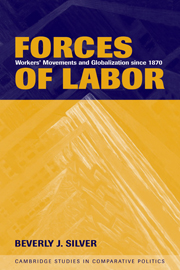Book contents
- Frontmatter
- Contents
- List of Figures
- List of Tables
- Preface and Acknowledgments
- 1 INTRODUCTION
- 2 LABOR MOVEMENTS AND CAPITAL MOBILITY
- 3 LABOR MOVEMENTS AND PRODUCT CYCLES
- 4 LABOR MOVEMENTS AND WORLD POLITICS
- 5 CONTEMPORARY DYNAMICS IN WORLD-HISTORICAL PERSPECTIVE
- Appendix A The World Labor Group Database: Conceptualization, Measurement, and Data Collection Procedures
- Appendix B Instructions for Recording Data from Indexes
- Appendix C Country Classifications
- References
- Index
- Cambridge Studies in Comparative Politics
1 - INTRODUCTION
Published online by Cambridge University Press: 05 June 2012
- Frontmatter
- Contents
- List of Figures
- List of Tables
- Preface and Acknowledgments
- 1 INTRODUCTION
- 2 LABOR MOVEMENTS AND CAPITAL MOBILITY
- 3 LABOR MOVEMENTS AND PRODUCT CYCLES
- 4 LABOR MOVEMENTS AND WORLD POLITICS
- 5 CONTEMPORARY DYNAMICS IN WORLD-HISTORICAL PERSPECTIVE
- Appendix A The World Labor Group Database: Conceptualization, Measurement, and Data Collection Procedures
- Appendix B Instructions for Recording Data from Indexes
- Appendix C Country Classifications
- References
- Index
- Cambridge Studies in Comparative Politics
Summary
Crisis of Labor Movements and Labor Studies
During the last two decades of the twentieth century, there was an almost complete consensus in the social science literature that labor movements were in a general and severe crisis. Declining strike activity and other overt expressions of labor militancy (Screpanti 1987; Shalev 1992), falling union densities (Western 1995; Griffin, McCammon, and Botsko 1990) and shrinking real wages and growing job insecurity (Bluestone and Harrison 1982; Uchitelle and Kleinfeld 1996) were among the trends documented. The bulk of the empirical literature focused on trends in wealthy countries (especially North America and Western Europe), yet many saw the crisis as world-scale, adversely affecting labor and labor movements around the globe.
This sense that labor movements are facing a general and severe crisis contributed to a crisis in the once vibrant field of labor studies. As William Sewell (1993: 15) noted: “Because the organized working class seems less and less likely to perform the liberating role assigned to it in both revolutionary and reformist discourses about labor, the study of working class history has lost some of its urgency” (see also Berlanstein 1993: 5).
For many, this double crisis of labor studies and labor movements is long term and structural – intimately tied to the momentous transformations that have characterized the last decades of the twentieth century going under the general rubric of “globalization.” For some, the crisis is not just severe, it is terminal. Aristide Zolberg, for one, argued that late-twentieth-century transformations have brought about the virtual disappearance of “the distinctive social formation we term ‘working class.’”
- Type
- Chapter
- Information
- Forces of LaborWorkers' Movements and Globalization Since 1870, pp. 1 - 40Publisher: Cambridge University PressPrint publication year: 2003
- 1
- Cited by

